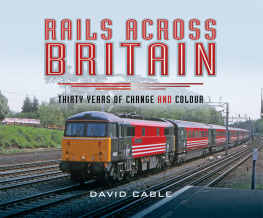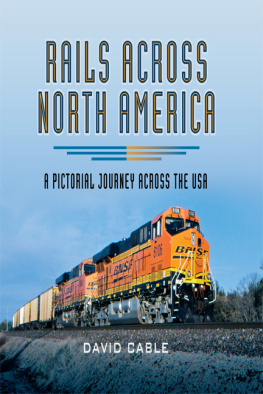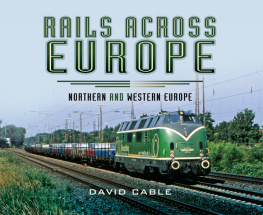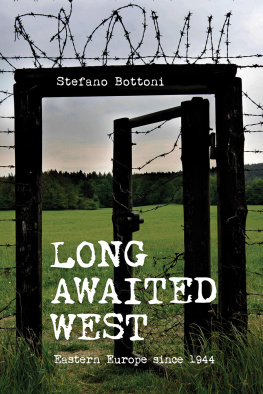Cable David - Rails Across Europe Eastern and Southern Europe
Here you can read online Cable David - Rails Across Europe Eastern and Southern Europe full text of the book (entire story) in english for free. Download pdf and epub, get meaning, cover and reviews about this ebook. year: 2016, publisher: Pen & Sword Books, genre: Home and family. Description of the work, (preface) as well as reviews are available. Best literature library LitArk.com created for fans of good reading and offers a wide selection of genres:
Romance novel
Science fiction
Adventure
Detective
Science
History
Home and family
Prose
Art
Politics
Computer
Non-fiction
Religion
Business
Children
Humor
Choose a favorite category and find really read worthwhile books. Enjoy immersion in the world of imagination, feel the emotions of the characters or learn something new for yourself, make an fascinating discovery.
- Book:Rails Across Europe Eastern and Southern Europe
- Author:
- Publisher:Pen & Sword Books
- Genre:
- Year:2016
- Rating:3 / 5
- Favourites:Add to favourites
- Your mark:
- 60
- 1
- 2
- 3
- 4
- 5
Rails Across Europe Eastern and Southern Europe: summary, description and annotation
We offer to read an annotation, description, summary or preface (depends on what the author of the book "Rails Across Europe Eastern and Southern Europe" wrote himself). If you haven't found the necessary information about the book — write in the comments, we will try to find it.
Rails Across Europe Eastern and Southern Europe — read online for free the complete book (whole text) full work
Below is the text of the book, divided by pages. System saving the place of the last page read, allows you to conveniently read the book "Rails Across Europe Eastern and Southern Europe" online for free, without having to search again every time where you left off. Put a bookmark, and you can go to the page where you finished reading at any time.
Font size:
Interval:
Bookmark:
First published in Great Britain in 2016 by
Pen & Sword Transport
An imprint of Pen & Sword Books Ltd
47 Church Street
Barnsley
South Yorkshire
S70 2AS
Copyright David Cable 2016
ISBN: 978 1 47384 432 2
PDF ISBN: 978 1 47384 435 3
EPUB ISBN: 978 1 47384 433 9
PRC ISBN: 978 1 47384 434 6
The right of David Cable to be identified as the author of this work has been asserted by him in accordance with the Copyright, Designs and Patents Act 1988. All rights reserved. No part of this publication may be reproduced or transmitted in any form or by any means, electronic or mechanical, including photocopy, recording or any information storage and retrieval system, without the prior written permission of the publisher, nor by way of trade or otherwise shall it be lent, re-sold, hired out or otherwise circulated without the publishers prior consent in any form of binding or cover other than that in which it is published and without a similar condition including this condition being imposed on the subsequent purchaser. David Cable 2016
Printed and bound in India by Replika Press Pvt. Ltd.
Pen & Sword Books Ltd incorporates the imprints of Pen & Sword Archaeology, Atlas, Aviation, Battleground, Discovery, Family History, History, Maritime, Military, Naval, Politics, Railways, Select, Social History, Transport, True Crime, and Claymore Press, Frontline Books, Leo Cooper, Praetorian Press, Remember When, Seaforth Publishing and Wharncliffe.
For a complete list of Pen & Sword titles please contact
Pen & Sword Books Limited
47 Church Street, Barnsley, South Yorkshire, S70 2AS, England
E-mail:
Website: www.pen-and-sword.co.uk
DAVID CABLE OTHER PUBLICATIONS
Railfreight in Colour (for the modeller and historian)
BR Passenger Sectors in Colour (for the modeller and historian)
Lost Liveries of Privatisation in Colour (for the modeller and historian)
Hydraulics in the West
The Blue Diesel Era
Rails Across North America A Pictorial Journey Across the USA
Rails Across Canada A Pictorial Journey Across Canada
Rails Across Europe Eastern and Southern
Contents
Introduction

During the nineteenth century, railways developed throughout the Mediterranean, Central European and Balkan countries, in most cases with state involvement, although Switzerland had more privately financed lines than most other countries. Lines were, in the main, of standard gauge as originally established in Great Britain, namely 4 8 (1435mm), with the major exceptions of the Ukraine, which as part of the original Romanov empire used 5 0 (1520mm), whilst the Iberian peninsula countries Spain and Portugal adopted 5 6 (1668mm).And especially in Switzerland and to a lesser extent Austria, a large number of narrow metre gauge lines were built, some of which are quite extensive, providing, for example, a through service from St Moritz to Zermatt.The difference in gauges has created problems on the main lines in the past, necessitating the transhipment of loads from one wagon to another, but improvements in bogie design have started to overcome this aspect.
Generally the systems remained as originally built, until the 1930s, when the Italians built the Direttissima High Speed line from Bologna to Firenze so as to avoid a route with severe operating restrictions due to the topography in that area.Then in the early 1980s, the first of a new generation of High Speed lines opened with the building of the LGV line from Paris to Lyon in France, which has subsequently fostered extensions through to Marseille and Montpellier, further lines to reach the Tours and Strasbourg areas, with plans to develop an LGV through to Bordeaux. In Italy, new High Speed lines now link Milano and Roma, with several other lines at the planning stage, whilst Spain now connects Barcelona, Madrid and Seville with the AVE network, which is being further extended to encompass Valencia amongst other cities. Several other countries are also considering the provision of specific lines on this model as an alternative to improving existing tracks to reduce journey times. A classic example of this applies in Switzerland, with the opening of new tunnels through the Alps replacing the old curving routes either side of the Gotthard and Lotschberg tunnels.
One application to assist trains surmount stiff gradients has been the use of rack systems, which have enabled extremely steep lines to be built, particularly on the narrow gauge lines in Switzerland, with the maximum being an incredible 48 per cent on the Pilatus railway, and which, from personal experience, really feels it!
In comparison with Northern Europe, much of the south and east of Europe is quite mountainous, and as a result lines and motive power had to deal with a much more complex set of circumstances. Experiments in electrification were soon put into practice, especially in Switzerland and Austria 15kV AC where hydroelectric power generation was available and relatively cheap. Over the years, as steam was replaced, electrified lines became widespread apart from some of the lines serving more remote areas, where costs were not justified. In general terms main lines in Southern France use 1,500 volts DC, Spain, Italy and Slovenia 3,000 volts DC, Switzerland and Austria 15kV AC and all other countries 25kV AC. Passenger services now increasingly comprise of trains using multiple electric units for both High Speed and conventional long distance and local services. As with those trains in Northern Europe, restaurant facilities are still available on some long distance services, but sleeping cars are now rare.
Freight services are all locomotive hauled, and an increasing number are intermodal or bulk carrying trains. Many services work through internationally, requiring developments in motive power to be capable of working through as much as possible to minimise delays in having to change locomotives to suit each countrys particular circumstances. Open Access operators have become more prevalent in recent times,cherry picking some of the more profitable business and leaving the major rail companies with the often loss-making residue. It is also noteworthy that the German company DB Schenker has developed operations into several Baltic countries.
Locomotives used in Southern Europe are, in the main, built by indigenous manufacturers such as Skoda in the Czech Republic and Ansaldo Breda in Italy. Bombardier and Siemens locomotives are widely used on through workings, and Alstom and Vossloh types can also be seen. Rather curiously, the original Eurosprinter design of Siemens was only adopted in Spain (class 252) and Portugal (class 5600), although it has been developed into the ES series.
The Open Access operators usually lease locomotives from organisations such as Dispolok, MRCE, Railpool and ELL. Of particular note is the importation to Hungary, Romania and Bulgaria of British locomotives, the class 56 and 86 diesel and electric locos used by Floyd in Hungary, and the class 87s and 92s used in the other two countries, some still carrying their British colours and names!
Other rolling stock has developed, being generally of larger capacity, all being mounted on bogies. Passenger facilities include better toilet provisions, and some limited arrangements for disabled persons compared with those in Northern Europe. Unfortunately, many southern countries suffer from epidemics of graffiti being applied to coaches and wagons, which hardly encourages passengers to use trains.
This volume has been designed to represent a selection of trains in most of the countries in the south and east of Europe, with the exception of some Balkan countries, which have not been visited by myself or friends. Some visits also took place some years ago.The pictures cover the last thirty years or so, with one or two before that.The majority of the photos are of my own taking, mostly on holidays. Some pictures were taken by Steve Sachs (now deceased), whose pictures were devoid of details, but research by Keith Fender, Brian Garvin and Nick Fotis has filled in some details.There are a few shots taken by my friends, Brian Denton, and a special selection of superb photos by Murray Lewis. My thanks to all of these people. Details of particular trains, especially freight workings, have not been available as compared with what is published in the UK, but generally passenger services have been identified.
Next pageFont size:
Interval:
Bookmark:
Similar books «Rails Across Europe Eastern and Southern Europe»
Look at similar books to Rails Across Europe Eastern and Southern Europe. We have selected literature similar in name and meaning in the hope of providing readers with more options to find new, interesting, not yet read works.
Discussion, reviews of the book Rails Across Europe Eastern and Southern Europe and just readers' own opinions. Leave your comments, write what you think about the work, its meaning or the main characters. Specify what exactly you liked and what you didn't like, and why you think so.









